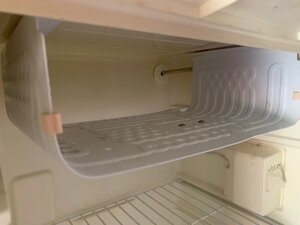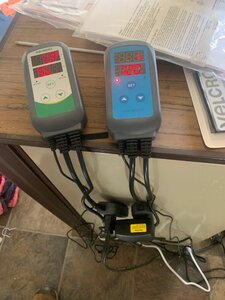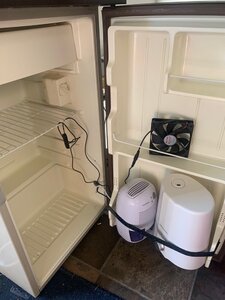- Feb 6, 2021
- 244
- 93
After making a mess of my first attempt at bacon, I learned that asking questions earlier rather than later saves a lot of frustration. I got great help with that issue so I'm pushing forward into a new project - a charcuterie meat curing chamber. I've though about doing this project for over 20 years, since the time I was stationed in Sicily while in the Navy. I had several opportunities back then to sample homemade Italian salumi that were incredibly good. Concerns over the botulism poisoning kept me from attempting my own curing setup years ago. The advent of YouTube instructional videos over the past few years has led me back to that original desire to cure meat at home after seeing that it really is a manageable project that can be done safely.
So anyways, I had a 3.2 sq ft. minifridge sitting unused in my garage. I'm posing pics of the cooling plate that apparently has refrigerant running through it to cool both the small freezer space above it and the main chamber of the fridge below. I ordered Inkbird temp and humidity controllers, a small ultrasonic humidifier and a small dehumidifier similar to models I've seen recommended on various sites and installed them in the door shelves (in order to maximize the remaining curing space in the main 'fridge chamber). I added a 12V DC fan with a variable rheostat that is still too powerful for this small setup, though for testing the controllers, it is fine as is and seems to help equilibrate humidity levels faster while I'm playing with RH settings. Also, I have not yet sealed the hole cut into the side of the fridge for chord placement. Though I placed some tape over most of the 1.25" opening, the chamber still seems to be affected by external RH.
Similar to many other people using mini-fridges for curing chambers, the temperature seems easy to maintain but the humidity values swing wildly when either the humidifier or dehumidifier is used. I've not tried them working together at the same time since I'm sure they would both run in an endless battle to add or remove humidity.
I live in SW WA. We experience wide swings of relative humidity depending on if the weather either feeding in off the coast or instead, coming from the dryer interior regions. I've seen the RH range from 45% to 98% in the last 12 hours of monitoring outdoor and indoor humidity. I've been playing with adjustments on the Inkbird controller and found that once the humidifier turns off, the RH will still rise around another 10% above the target. If the exterior RH is above 80%, then the internal RH continues to click slowly higher and can reach above 90% with time.
When I run the dehumidifier, it works slowly but effectively when the external RH is above the target point. When external humidity is below 60%, the dehumidifier can easily remove an additional 20% humidity in just a minute or two after the controller turns it off. I believe that is because it utilizes thermoelectric (peltier) cooling, which I imagine continues to dehumidify until internal temperature equalizes across the heat pump gradient (at least that's my best guess). The chamber often gets down to 52% or so if the dehumidifier is run for more than three minutes or so, even though the controller turned it off at 71%. Additionally, it seems that since both dehumidifier and humidifier always have at least some water in their tanks, that internal pool of water is also causing some increase in RH even when those units are off.
Anyways, there's a lot of moving parts to this initial setup and I'm feeling a bit frustrated with my inability to manage the humidity better. I'm hoping that some of you have ideas that might ease my suffering and at least reduce the radical humidity swings I'm experiencing. Thanks in advance for your help.
George
So anyways, I had a 3.2 sq ft. minifridge sitting unused in my garage. I'm posing pics of the cooling plate that apparently has refrigerant running through it to cool both the small freezer space above it and the main chamber of the fridge below. I ordered Inkbird temp and humidity controllers, a small ultrasonic humidifier and a small dehumidifier similar to models I've seen recommended on various sites and installed them in the door shelves (in order to maximize the remaining curing space in the main 'fridge chamber). I added a 12V DC fan with a variable rheostat that is still too powerful for this small setup, though for testing the controllers, it is fine as is and seems to help equilibrate humidity levels faster while I'm playing with RH settings. Also, I have not yet sealed the hole cut into the side of the fridge for chord placement. Though I placed some tape over most of the 1.25" opening, the chamber still seems to be affected by external RH.
Similar to many other people using mini-fridges for curing chambers, the temperature seems easy to maintain but the humidity values swing wildly when either the humidifier or dehumidifier is used. I've not tried them working together at the same time since I'm sure they would both run in an endless battle to add or remove humidity.
I live in SW WA. We experience wide swings of relative humidity depending on if the weather either feeding in off the coast or instead, coming from the dryer interior regions. I've seen the RH range from 45% to 98% in the last 12 hours of monitoring outdoor and indoor humidity. I've been playing with adjustments on the Inkbird controller and found that once the humidifier turns off, the RH will still rise around another 10% above the target. If the exterior RH is above 80%, then the internal RH continues to click slowly higher and can reach above 90% with time.
When I run the dehumidifier, it works slowly but effectively when the external RH is above the target point. When external humidity is below 60%, the dehumidifier can easily remove an additional 20% humidity in just a minute or two after the controller turns it off. I believe that is because it utilizes thermoelectric (peltier) cooling, which I imagine continues to dehumidify until internal temperature equalizes across the heat pump gradient (at least that's my best guess). The chamber often gets down to 52% or so if the dehumidifier is run for more than three minutes or so, even though the controller turned it off at 71%. Additionally, it seems that since both dehumidifier and humidifier always have at least some water in their tanks, that internal pool of water is also causing some increase in RH even when those units are off.
Anyways, there's a lot of moving parts to this initial setup and I'm feeling a bit frustrated with my inability to manage the humidity better. I'm hoping that some of you have ideas that might ease my suffering and at least reduce the radical humidity swings I'm experiencing. Thanks in advance for your help.
George








